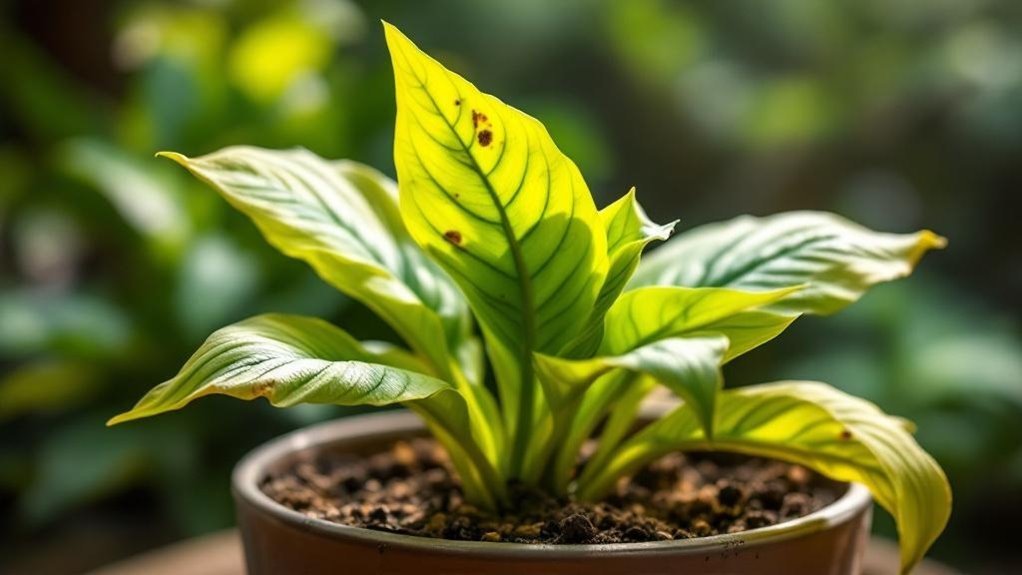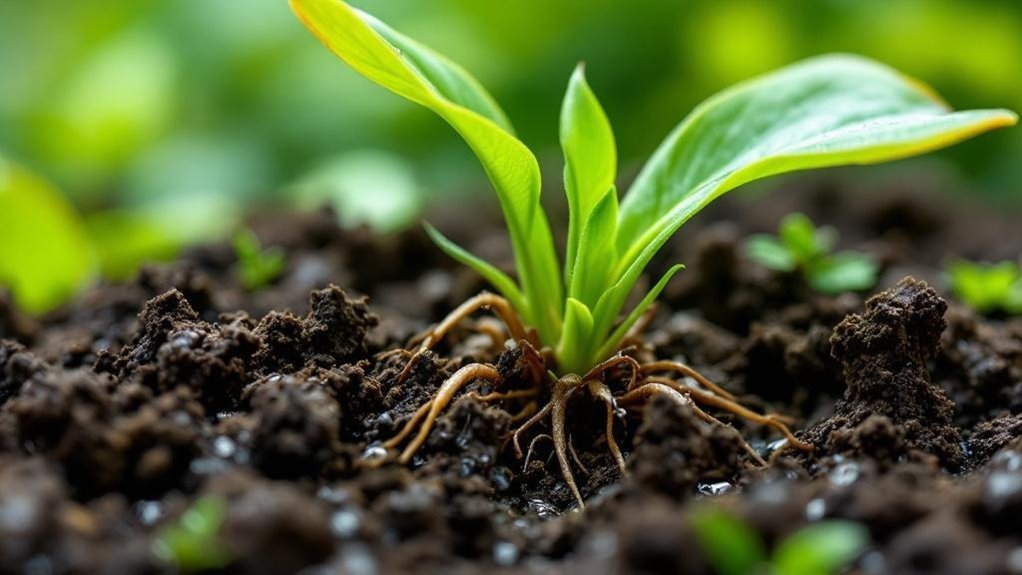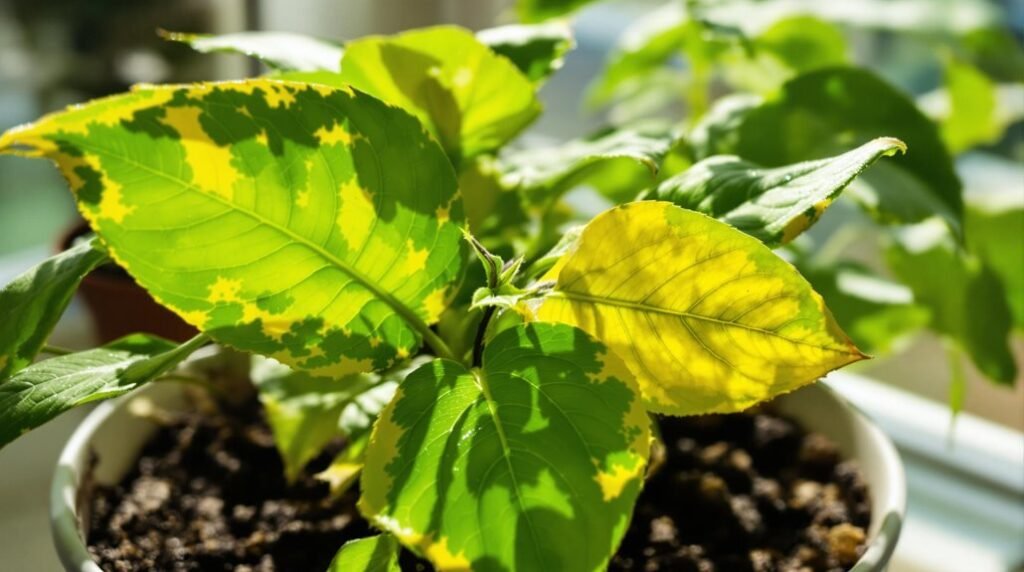If you’ve noticed your plant leaves turning yellow, it’s a clear sign something’s off. It could be as simple as watering habits or as complex as nutrient deficiencies or pests. Yellow leaves don’t just affect your plant’s appearance—they signal underlying issues that need attention. Understanding what’s causing this change is key to restoring your plant’s health and vibrancy. Let’s explore the most common reasons behind yellowing leaves and what you can do about them.
Overwatering and Its Effects
Although watering your plants is essential, overwatering often causes their leaves to turn bright yellow by suffocating the roots and limiting oxygen in the soil.
Overwatering can turn leaves yellow by suffocating roots and reducing soil oxygen.
When you water too frequently, the soil moisture stays high, which can suffocate roots and lead to root rot. You might notice yellow leaves alongside soggy soil and blackened stem bases.
To prevent this, always check if your pots have drainage holes; without them, excess water accumulates, damaging roots. It’s best to let the top inch of soil dry out before watering again.
Monitoring environmental factors like humidity and temperature also helps you adjust watering appropriately, avoiding overwatering.
Signs of Underwatering
Anyone caring for plants can quickly spot signs of underwatering by noticing yellow leaves that curl inward and dry soil. You’ll often see older leaves dropping and brown edges forming, clear signals that your plant needs more water. Underwatering stresses the plant, limiting nutrient absorption, so act promptly. To fix this, soak the soil thoroughly and aerate compacted areas to improve water uptake. Recovery varies—some plants bounce back fast, others take days.
| Symptom | Cause |
|---|---|
| Yellow curling leaves | Lack of water in soil |
| Dry, compacted soil | Poor water absorption |
| Brown leaf edges | Prolonged dehydration |
| Leaf drop | Severe underwatering |
Watching these signs helps you prevent long-term damage from underwatering.
Nutrient Deficiencies Causing Yellow Leaves

When your plant’s leaves turn yellow, nutrient deficiencies could be the cause, and identifying the specific pattern helps you target the problem.
For example, magnesium deficiency causes yellow patches between leaf veins on older leaves, which you can fix by adding Epsom salts or lime.
Iron deficiency shows as yellow leaves with small green veins, signaling the need to adjust soil pH below 7.0 for better nutrient uptake.
Calcium deficiency results in misshapen, yellow leaves and can be corrected with gypsum in alkaline soils or lime in acidic ones.
Recognizing these nutrient deficiencies lets you address yellow leaves effectively, ensuring your plant gets the crucial elements it needs to thrive.
Improper Soil Ph Levels
Nutrient deficiencies often stem from improper soil pH levels, which directly impact how well your plant can absorb nutrients. When soil pH is too high or too low, it causes chlorosis—yellowing leaves from lack of chlorophyll. Most plants need a pH between 6.0 and 7.0, but acid-loving plants prefer 4.5 to 6.0. Conduct a soil test to find your soil’s pH and adjust it accordingly by adding lime to raise pH or sulfur to lower it. Regular checks prevent nutrient deficiencies and keep your plants healthy.
| Soil pH Range | Plant Preference |
|---|---|
| 4.5 – 6.0 | Acid-loving plants |
| 6.0 – 7.0 | Most garden plants |
| <4.5 | Too acidic |
| >7.0 | Too alkaline |
Poor Drainage and Soil Compaction

Two common soil issues that lead to yellowing leaves are poor drainage and soil compaction.
Poor drainage causes water to pool around the roots, suffocating them by limiting oxygen access, which results in yellowing leaves.
Soil compaction similarly restricts the movement of water, oxygen, and nutrients, making it hard for roots to thrive.
To fix this, use well-draining soil mixes like Pennington Rejuvenate Natural & Organic Garden Soil Mix and guarantee your containers have adequate drainage holes.
Regularly aerate the soil to reduce compaction and promote healthy root circulation.
If you suspect soil compaction, gently remove your plant to check the roots.
Repotting in a larger container with fresh, well-draining soil can help restore root health and prevent further yellowing leaves.
Root Damage and Root Rot
If your plant’s leaves are turning yellow despite proper watering, root damage or root rot might be the culprit.
Root damage can result from physical injury, disease, or poor soil conditions, causing nutrient deficiency as roots fail to absorb water and nutrients effectively.
Root rot, commonly caused by overwatering and lack of proper drainage, suffocates roots, leading to yellow leaves and potential plant death.
Check for blackened, mushy roots and a foul odor, signs that the root system is deteriorating.
To prevent these issues, guarantee your pot has proper drainage and only water when the top inch of soil is dry.
Regularly inspect roots by gently removing the plant from its container, allowing early detection and timely action like repotting or root pruning.
Temperature Stress and Its Impact
Beyond root issues, temperature stress can also cause your plant’s leaves to turn yellow. When exposed to cool temperatures for too long, your plant’s metabolism slows down, disrupting chlorophyll production and leading to yellowing leaves.
If your plant faces high temperatures, especially sensitive varieties, leaf scorch may occur, causing yellowing and browning at the edges. Rapid temperature changes, like moving between indoors and outdoors, can further stress your plant, triggering yellow leaves as a response.
Consistent exposure to temperatures below 50°F (10°C) risks chilling injury, which causes wilting, yellowing, and leaf drop. To protect your plant, monitor evening temperatures and shield it from late frost.
Temperatures below 50°F can cause chilling injury, leading to wilting, yellow leaves, and leaf drop.
Managing temperature stress effectively helps maintain vibrant, healthy leaves.
Insufficient or Excessive Light Exposure
When your plant doesn’t get the right amount of light, its leaves often turn yellow as a clear sign of stress. Insufficient light exposure prevents plants from photosynthesizing properly, leading to yellowing leaves, especially on older foliage. On the other hand, excessive light, particularly direct sunlight on shade-loving plants, can scorch the leaves, causing yellowing and brown edges. Different plants have specific light needs, so matching placement with light requirements is key to preventing yellowing leaves.
| Light Condition | Affected Leaves | Common Signs |
|---|---|---|
| Insufficient Light | Older, lower leaves | Yellow, weak growth |
| Excessive Light | Upper, sun-exposed leaves | Yellowing, brown edges |
| Shade-Loving Plants | Sensitive to bright light | Leaf scorch, yellowing |
| Sun-Loving Plants | Require bright light | Healthy green leaves |
| Prevention | Proper placement | Consistent light exposure |
Pests Leading to Leaf Yellowing
Although pests like aphids, spider mites, and whiteflies may be small, they can cause your plant’s leaves to turn yellow by sucking sap and depriving the plant of essential nutrients.
These pests lead to nutrient deficiencies, resulting in yellowing leaves, stippling, curling, or leaf deformation. To catch infestations early, regularly inspect the undersides of leaves and stems where pests often hide.
Using integrated pest management techniques, such as applying insecticidal soap or neem oil, helps control pest populations effectively. Keeping your plants healthy with proper watering, light, and soil conditions also reduces their vulnerability to pests like spider mites.
Fungal and Bacterial Leaf Spot Diseases
If your plant’s leaves develop irregular yellow spots that soon turn brown or black, fungal or bacterial leaf spot diseases might be the cause.
These diseases thrive when you overwater your plants and neglect air circulation. Fungal infections often show fuzzy growth or spores, while bacterial spots may appear water-soaked and cause wilting.
Overwatering and poor airflow promote fungal fuzzy growth or water-soaked bacterial spots causing wilting.
To manage these issues, promptly remove affected leaves and improve airflow around your plants. Avoid overwatering, as excess moisture encourages pathogen growth.
Applying the right fungicides or bactericides can help stop the spread. Regularly check your plants for pests, since they can worsen leaf spot problems.
Viral Infections Affecting Leaf Color
Besides fungal and bacterial issues, viral infections can also cause your plant’s leaves to turn yellow, but with different patterns and symptoms.
These infections often lead to uneven chlorosis, where some areas yellow while others stay green, signaling disrupted chlorophyll production. Common culprits like Tobacco Mosaic Virus (TMV) reduce plant vigor, causing stunted growth and vulnerability to pests.
To help you recognize viral infections, watch for:
- Mosaic or mottled yellow-green patterns on leaves
- Ringspots or streaks disrupting normal leaf color
- Stunted growth and weakened plant vigor
- Spread through mechanical contact, insects, or contaminated tools
Implement preventative measures such as sterilizing your tools and controlling pests to minimize infection risks and keep your plants healthy.
Natural Aging and Leaf Shedding Processes
When older leaves start turning yellow, it usually means your plant is naturally shedding them to focus energy on new growth. This natural leaf aging process is common, especially in deciduous plants that seasonally drop leaves. Leaves yellow as nutrients move from older leaves to new shoots, conserving resources. If your plant is healthy, this yellowing is normal and not a concern.
| Cause | Description | Result |
|---|---|---|
| Natural leaf aging | Older leaves deteriorate over time | Leaves yellow, then drop |
| Energy allocation | Resources shift to new growth | Older leaves yellow |
| Seasonal leaf shedding | Deciduous plants lose leaves during seasons | Yellowing is common |
| Plant health status | Healthy plants show normal leaf yellowing | No need for intervention |
Frequently Asked Questions
What Is the Most Common Cause of Plant Yellowing?
You’re most likely overwatering your plant, causing roots to suffocate and rot. Make sure you let the soil dry out between waterings, so your plant can breathe and stay healthy without yellowing leaves.
How Do You Fix Yellowing Plant Leaves?
You don’t need a time machine; just water your plant properly, improve soil drainage, and use balanced fertilizer. Check for pests regularly, and treat them promptly to bring your yellow leaves back to vibrant green health.
What Deficiency Causes Yellowing of Leaves in Plants?
You’re likely dealing with nutrient deficiencies causing yellow leaves. Nitrogen affects older leaves, iron causes yellowing between veins, magnesium shows white stripes, potassium yellows edges, and calcium leads to misshapen, crispy new leaves.
Do Yellow Plants Mean Too Much Water?
Yes, yellow leaves can mean you’re overwatering your plant. When soil stays too wet, roots suffocate, causing yellowing. Let the soil dry between waterings, improve drainage, and adjust light to help your plant recover.
Final Thoughts
You might think yellow leaves mean your plant is doomed, but that’s rarely the case. Yellowing is usually a clear signal your plant needs a little extra care—whether it’s adjusting watering, improving soil, or checking for pests. By paying attention to these common causes, you can often revive your plant and help it thrive again. Don’t give up; understanding the problem is the first step to healthier, greener leaves.
